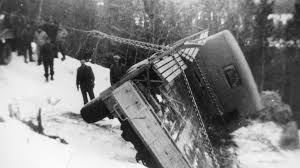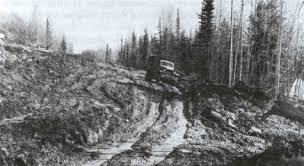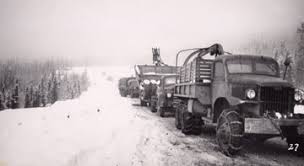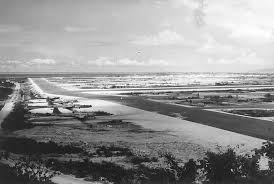Alaska Highway was road to ruin
U.S. army engineers building the Alaska Highway pose by the ice-covered High Level Bridge in Edmonton.
For
organizers planning to mark the 50th anniversary of the completion of
the Alaska Highway in 1992, it was all about celebrating an engineering
feat. But the Alcan Highway was also a road to ruin that brought disease
and death to Northern natives.
“For so long the native side of the story hasn’t been told and it’s a side that non-natives don’t want to hear,” said James Allen, a Southern Tutchone native coordinating Yukon aboriginal involvement in the highway’s golden anniversary.
“The highway brought a lot of sickness and disease and illness that native people were not immune to, so it devastated a lot of communities. In each community there were endless funeral processions during the building of the Alaska Highway and after.”
Edmonton was the staging area for the 2,430-km road which was originally built mostly by the U.S. army as a supply route to safeguard Alaska from Japanese invasion during the Second World War. It was opened to the public in 1948.
More than 20,000 soldiers and civilians worked on the Highway from March 8 to Oct. 28, 1942.
Along with the dysentery, measles, jaundice, whooping cough, mumps and meningitis, they brought irreversible change to native culture and lifestyle, Allen said.
“Around that time the majority of native people were hunters, trappers, and fisherman, but when the highway came up they were introduced to a wage-earning way of life and some people did OK, some people made it as wage earners, but the majority of people were lost.
“They became more dependent on alcohol than anything.”
With the advent of easy liquor came wife abuse, child abuse and “a lot of horror stories about native women being taken advantage of by soldiers and civilians building the highway,” he said. Native children were taken from their homes to residential schools which were institutionalized after the highway was built.
Still, conscious of the economic potential of having thousands of international visitors descend on the area, the natives were determined not to be left out.
But instead of the air show, mammoth road rally and snowmobile safari from Dawson Creek to Whitehorse planned during the anniversary celebrations, natives living along the route planned to gather in small, quiet groups for healing ceremonies, nursing the wounds the road brought to their society.
czdeb@edmontonjournal.com
“For so long the native side of the story hasn’t been told and it’s a side that non-natives don’t want to hear,” said James Allen, a Southern Tutchone native coordinating Yukon aboriginal involvement in the highway’s golden anniversary.
“The highway brought a lot of sickness and disease and illness that native people were not immune to, so it devastated a lot of communities. In each community there were endless funeral processions during the building of the Alaska Highway and after.”
Edmonton was the staging area for the 2,430-km road which was originally built mostly by the U.S. army as a supply route to safeguard Alaska from Japanese invasion during the Second World War. It was opened to the public in 1948.
More than 20,000 soldiers and civilians worked on the Highway from March 8 to Oct. 28, 1942.
Along with the dysentery, measles, jaundice, whooping cough, mumps and meningitis, they brought irreversible change to native culture and lifestyle, Allen said.
“Around that time the majority of native people were hunters, trappers, and fisherman, but when the highway came up they were introduced to a wage-earning way of life and some people did OK, some people made it as wage earners, but the majority of people were lost.
“They became more dependent on alcohol than anything.”
With the advent of easy liquor came wife abuse, child abuse and “a lot of horror stories about native women being taken advantage of by soldiers and civilians building the highway,” he said. Native children were taken from their homes to residential schools which were institutionalized after the highway was built.
Still, conscious of the economic potential of having thousands of international visitors descend on the area, the natives were determined not to be left out.
But instead of the air show, mammoth road rally and snowmobile safari from Dawson Creek to Whitehorse planned during the anniversary celebrations, natives living along the route planned to gather in small, quiet groups for healing ceremonies, nursing the wounds the road brought to their society.
czdeb@edmontonjournal.com
© Copyright (c) The Edmonton Journal




There are several websites that provide in-sights. This one seems to be a pretty wellpresented one with lots of solid information.
http://jukebox.uaf.edu/ak_highway/html/index.html


by Doug Brown, at the Alaska Native Heritage Center in Anchorage, Alaska.
I grabbed this from another site.
In the early spring of 1942, when the Army Corps of Engineers arrived to begin building the Alaska Highway, Alaska's population was approximately 73,000. About half of those residents were Native Alaskans, members of indigenous groups who inhabited Alaska before it was colonized by Russia. Native Alaskans are divided into three broad groups: the Aleuts, the Inuit, and the many different Indian tribes.
Aleuts

The Aleuts, who call themselves Unangan, lived in the Aleutian Islands off the coast of mainland Alaska. Some anthropologists believe their ancestors migrated to the Aleutians 7,000 years ago. Aleuts had both permanent and seasonal homes. Permanent Aleutian villages consisted of underground homes mainly located on the northern coasts of the islands that faced the Bering Sea, due to the abundance of resources on that side. Aleutian culture is based heavily on the sea. They are famous fishers and hunters, and are known for their basketry.

Inuit
The Aleuts lived on ice-free waters, but the Inuit (who are also known as the Eskimo) were surrounded by the icy northern seas of Western Alaska. As a result, the Inuit were more mobile that the Aleuts. One distinguishing feature of the Inuit was their near total dependence on the sea. Their food, clothing, furnishing for their homes, and fuel all came from the marine life that they hunted, such as whales and seals.

First Nations
The third group of Native Alaskans consisted of several Indian tribes (also known as First Nations). Two of the larger groups were the Tlingit and Haida, who resided in the southeastern inland region of Alaska. While these groups were adept at fishing, they were also known for their mountaineering skills. They were famed for their totem poles and their potlatches, gatherings of friends and family to celebrate important milestones in an individual's life, such as a first hunt or a funeral. Both of these tribes were seasonally mobile hunter gatherers with their own distinguishing features, most prominently linguistic ones.
Illnesses
The influx of civilians and military personnel into Alaska had a devastating effect on the Native Alaskans, who had already suffered a negative impact. In the century of Russian and American colonization prior to World War II, contact with outsiders had subjected Native Alaskans to diseases for which they lacked immunity, including meningitis, influenza, chicken pox and whooping cough.

Incursions
With the newcomers' arrival, Native Alaskans' whole way of living became endangered. Highway-building made travel and access much easier within Alaska. During their recreation time, the Army engineers would go fishing, or go hunting with their military-issued guns, for which they otherwise had little use. Along the narrow corridor of the highway, the outsiders depleted the natural resources on which the Native Alaskans depended for subsistence.
Dwindling Minority
As a result of disease, cultural confusion and the growing number of whites, the percentage of Native Alaskans in the general Alaskan population plummeted from 45 percent in 1940 to 26 percent in 1950 to 19 percent at the time of statehood in 1959. The highway construction led to a new era for the original Alaskans.

A World Ended
Historian Ken Coates described the effect of the Alaska Highway on the area's native population: "Construction projects transformed aboriginal life in the northwest very quickly and very profoundly. There was only occasional work to be found, they didn't hire very many aboriginal people to work. The women got involved selling handicrafts and doing some domestic work... There were a lot of attacks on aboriginal people, some rapes of native women, for example. A lot of misuse of alcohol with aboriginal people. So, a world had ended. A lifestyle that had been in place in many ways for centuries, but certainly since the arrival of the fur traders in the middle of the 19th century. It's a hundred years of fishing, and trapping, and sort of casual engagement with the market economy, poof, gone. Overnight."
Revitalization
Today, Alaska Natives account for just over 15 percent of the total Alaskan population of approximately 648,000 people. Since the 1960s and 1970s, aboriginal autonomy has rebounded in Alaska. The Alaska Native Claims Settlement Act of 1971 officially ended native land ownership claims while creating regional corporations that administered approximately one-ninth of Alaskan territory; the shareholders of the corporations are the native peoples. The legal battles for rights to their ancestral land began a revitalization of native society that is evident today.
There are several websites that provide in-sights. This one seems to be a pretty wellpresented one with lots of solid information.
http://jukebox.uaf.edu/ak_highway/html/index.html
by Doug Brown, at the Alaska Native Heritage Center in Anchorage, Alaska.
I grabbed this from another site.
In the early spring of 1942, when the Army Corps of Engineers arrived to begin building the Alaska Highway, Alaska's population was approximately 73,000. About half of those residents were Native Alaskans, members of indigenous groups who inhabited Alaska before it was colonized by Russia. Native Alaskans are divided into three broad groups: the Aleuts, the Inuit, and the many different Indian tribes.
Aleuts
Library of Congress
An Aleutian in front of an underground home
The Aleuts, who call themselves Unangan, lived in the Aleutian Islands off the coast of mainland Alaska. Some anthropologists believe their ancestors migrated to the Aleutians 7,000 years ago. Aleuts had both permanent and seasonal homes. Permanent Aleutian villages consisted of underground homes mainly located on the northern coasts of the islands that faced the Bering Sea, due to the abundance of resources on that side. Aleutian culture is based heavily on the sea. They are famous fishers and hunters, and are known for their basketry.
Arttoday
An Inuit family
The Aleuts lived on ice-free waters, but the Inuit (who are also known as the Eskimo) were surrounded by the icy northern seas of Western Alaska. As a result, the Inuit were more mobile that the Aleuts. One distinguishing feature of the Inuit was their near total dependence on the sea. Their food, clothing, furnishing for their homes, and fuel all came from the marine life that they hunted, such as whales and seals.
Library of Congress
A Haida totem pole
The third group of Native Alaskans consisted of several Indian tribes (also known as First Nations). Two of the larger groups were the Tlingit and Haida, who resided in the southeastern inland region of Alaska. While these groups were adept at fishing, they were also known for their mountaineering skills. They were famed for their totem poles and their potlatches, gatherings of friends and family to celebrate important milestones in an individual's life, such as a first hunt or a funeral. Both of these tribes were seasonally mobile hunter gatherers with their own distinguishing features, most prominently linguistic ones.
Illnesses
The influx of civilians and military personnel into Alaska had a devastating effect on the Native Alaskans, who had already suffered a negative impact. In the century of Russian and American colonization prior to World War II, contact with outsiders had subjected Native Alaskans to diseases for which they lacked immunity, including meningitis, influenza, chicken pox and whooping cough.
National Archives
Two young Native Alaskans
With the newcomers' arrival, Native Alaskans' whole way of living became endangered. Highway-building made travel and access much easier within Alaska. During their recreation time, the Army engineers would go fishing, or go hunting with their military-issued guns, for which they otherwise had little use. Along the narrow corridor of the highway, the outsiders depleted the natural resources on which the Native Alaskans depended for subsistence.
Dwindling Minority
As a result of disease, cultural confusion and the growing number of whites, the percentage of Native Alaskans in the general Alaskan population plummeted from 45 percent in 1940 to 26 percent in 1950 to 19 percent at the time of statehood in 1959. The highway construction led to a new era for the original Alaskans.
National Archives
An Inuit woman outside her home
Historian Ken Coates described the effect of the Alaska Highway on the area's native population: "Construction projects transformed aboriginal life in the northwest very quickly and very profoundly. There was only occasional work to be found, they didn't hire very many aboriginal people to work. The women got involved selling handicrafts and doing some domestic work... There were a lot of attacks on aboriginal people, some rapes of native women, for example. A lot of misuse of alcohol with aboriginal people. So, a world had ended. A lifestyle that had been in place in many ways for centuries, but certainly since the arrival of the fur traders in the middle of the 19th century. It's a hundred years of fishing, and trapping, and sort of casual engagement with the market economy, poof, gone. Overnight."
Revitalization
Today, Alaska Natives account for just over 15 percent of the total Alaskan population of approximately 648,000 people. Since the 1960s and 1970s, aboriginal autonomy has rebounded in Alaska. The Alaska Native Claims Settlement Act of 1971 officially ended native land ownership claims while creating regional corporations that administered approximately one-ninth of Alaskan territory; the shareholders of the corporations are the native peoples. The legal battles for rights to their ancestral land began a revitalization of native society that is evident today.

No comments:
Post a Comment